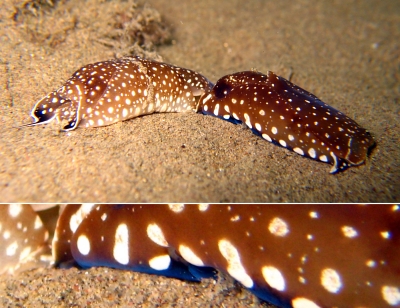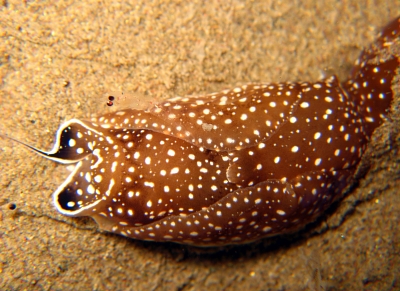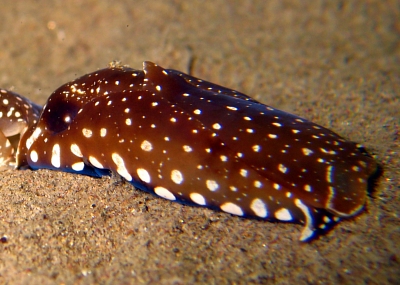Aglaja tricolorata from the French mediterranean
July 4, 2008
From: Dominique Horst


Concerning message #19319:
Hello Bill,
These Aglaja tricolorata are mating or supposed to be, even if they look quite different. In fact, one has a blue border line and the second doesn't.
I can also send to the forum, shots that show the detail of the posterior flagellum.
Locality: Cagnes, 8 m, France, Mediterranean sea, 1 July 2008, muddy. Length: 40 mm. Photographer: Dominique Horst.
Kind regards,
Dom.
dominique.horst@wanadoo.fr
Horst, D., 2008 (Jul 4) Aglaja tricolorata from the French mediterranean. [Message in] Sea Slug Forum. Australian Museum, Sydney. Available from http://www.seaslugforum.net/find/21672
Dear Dom.,
Photos of Aglaja tricolorata are of special interest to me because one of my first research projects - 40 years ago - was on species of the family Aglajidae and the first problem was to sort out just how many genera there were. The biggest stumbling block was the lack of information on the mediterranean species Aglaja tricolorata on which the genus Aglaja was based. Adding to the confusion was the other mediterranean species 'Aglaja' depicta, which we now know belongs to the genus Philinopsis, which had been confused with A. tricolorata by some early workers and so we had no real idea of the anatomy of either species. Unfortunately I was unable at the time to borrow specimens of either species. It's only in recent years that I have at last seen good photos, like yours, of Aglaja tricolorata, which show the posterior flagellum, the pointed (almost tentacular) extensions to the anterior end of the parapodia, and the rounded posterior 'tip' to the head shield.
As to your question about colour differences. I think the blue band you can see is a not a pigment colour, but what we call a 'physical' colour caused by light being refracted through the fur-like layer of microscopic cilia which cover the surface of the skin. For some reason only blue light seems to be reflected, and can only be seen from certain angles. This blue sheen can be seen most clearly in darker animals which explains why you can see it in the dark brown specimen but not the light brown one. I would certainly like to add some close-up shots of the flagellum.
Best wishes,
Bill Rudman
Related messages
-
Re: Aglaja tricolorata 'colour variation'
From: Dominique Horst, August 17, 2009 -
Re: Aglaja tricolorata 'feeding'
From: Dominique Horst, September 5, 2008 -
A damaged Aglaja tricolorata
From: Dominique Horst, September 4, 2008 -
Aglaja tricolorata 'trailing'
From: Dominique Horst, July 17, 2008 -
Re: Aglaja tricolorata from the French mediterranean
From: Dominique Horst, July 7, 2008 -
Aglaja tricolorata from Malta
From: Patricia Peels, February 1, 2007
